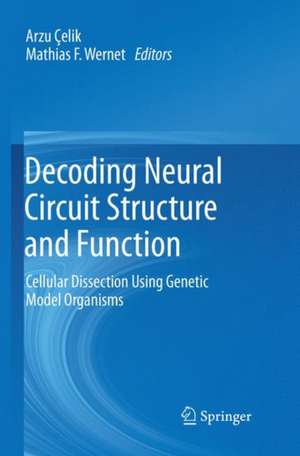Decoding Neural Circuit Structure and Function: Cellular Dissection Using Genetic Model Organisms
Editat de Arzu Çelik, Mathias F. Werneten Limba Engleză Paperback – 3 aug 2018
Current efforts focus on integrating knowledge gained from three interrelated fields of research: (1) understanding how the fates of different cell types are specified during development, (2) revealing the synaptic connections between identified cell types (“connectomics”) using high-resolution three-dimensional circuit anatomy, and (3) causal testing of how iden
tified circuit elements contribute to visual perception and behavior.
| Toate formatele și edițiile | Preț | Express |
|---|---|---|
| Paperback (1) | 802.74 lei 38-44 zile | |
| Springer International Publishing – 3 aug 2018 | 802.74 lei 38-44 zile | |
| Hardback (1) | 820.64 lei 38-44 zile | |
| Springer International Publishing – 8 aug 2017 | 820.64 lei 38-44 zile |
Preț: 802.74 lei
Preț vechi: 1056.23 lei
-24% Nou
Puncte Express: 1204
Preț estimativ în valută:
153.61€ • 160.78$ • 127.85£
153.61€ • 160.78$ • 127.85£
Carte tipărită la comandă
Livrare economică 27 martie-02 aprilie
Preluare comenzi: 021 569.72.76
Specificații
ISBN-13: 9783319861432
ISBN-10: 3319861433
Pagini: 518
Ilustrații: XIII, 518 p. 92 illus., 81 illus. in color.
Dimensiuni: 155 x 235 mm
Greutate: 0 kg
Ediția:Softcover reprint of the original 1st ed. 2017
Editura: Springer International Publishing
Colecția Springer
Locul publicării:Cham, Switzerland
ISBN-10: 3319861433
Pagini: 518
Ilustrații: XIII, 518 p. 92 illus., 81 illus. in color.
Dimensiuni: 155 x 235 mm
Greutate: 0 kg
Ediția:Softcover reprint of the original 1st ed. 2017
Editura: Springer International Publishing
Colecția Springer
Locul publicării:Cham, Switzerland
Cuprins
1. Note from the editors.- 2. Overview: The current state of neural circuit dissection in genetic model organisms.- Part I: High-resultion Neuroanatomy using molecular-genetic tools.- 3. Neuroanatomical techniques in invertebrate model organisms (flies, worms).- 4. Neuroanatomical techniques in vertebrate model systems (mice, monkeys).- 5. The current state of whole-brain connectomics in invertebrates.- 6. The progress in large-scale connectomics in vertebrates.- 7. Establishing synaptic connection the invertebrate brain (neural superposition?).- 8. Target selection and synaptogenesis in vertebrate models.- Part II: The behavioral contributions of identified circuit elements.- 9. Behavioral paradigms for dissecting neural circuitry in invertebrates.- 10. Behavioral paradigms for dissecting neural circuitry in vertebrates.- 11. Targeted disruption of neuronal activity in behaving invertebrate models.- 12. Circuit brea
king and optogenetics in vertebrates.- 13. Modeling of neural circuits in invertebrates.- 14. Modeling of neural circuits in vertebrates.- Part III: The functional contribution of identified cells to the circuit.- 15. The electrophysiological characterization of identified invertebrate circuit elements.- 16. Electrophysiology in combination with molecular genetic tools in vertebrates.- 17. Genetically encoded activity sensors in invertebrates.- 18. Genetically encoded activity sensors in vertebrates.- 19. Combining circuit breaking tools and the visualization of activity in invertebrates.- 20. Visualization of neuronal activity while circuit breaking in vertebrates.- Part IV: Molecular determinants of cell type diversity.- 21. The developmental origin of cell type diversity in invertebrate brains.- 22. The development of neuronal cell type diversity in the vertebrate brain.- 23. Transcriptional profiling of identified circuit elements in invertebrates.- 24. Transcriptional profiling in neural circuits in vertebrates.Notă biografică
Mathias Wernet is currently a professor of Neurobiology at the Freie University of Berlin. His current research deals with the neural circuitry underlying visual behaviors in Drosophila melanogaster and integrates studies spanning anatomy, behavior, and physiology.
Arzu Celik is a professor of Developmental Neurobiology at Bogazici University in Istanbul, Turkey. Her research focuses on the generation of neuronal diversity and mechanisms of axon guidance in the visual and olfactory systems of Drosophila melanogaster.
Arzu Celik is a professor of Developmental Neurobiology at Bogazici University in Istanbul, Turkey. Her research focuses on the generation of neuronal diversity and mechanisms of axon guidance in the visual and olfactory systems of Drosophila melanogaster.
Textul de pe ultima copertă
This book offers representative examples from fly and mouse models to illustrate the ongoing success of the synergistic, state-of-the-art strategy, focusing on the ways it enhances our understanding of sensory processing. The authors focus on sensory systems (vision, olfaction), which are particularly powerful models for probing the development, connectivity, and function of neural circuits, to answer this question: How do individual nerve cells functionally cooperate to guide behavioral responses? Two genetically tractable species, mice and flies, together significantly further our understanding of these processes.
Current efforts focus on integrating knowledge gained from three interrelated fields of research: (1) understanding how the fates of different cell types are specified during development, (2) revealing the synaptic connections between identified cell types (“connectomics”) using high-resolution three-dimensional circuit anatomy, and (3) causal testing of how iden
tified circuit elements contribute to visual perception and behavior.
Current efforts focus on integrating knowledge gained from three interrelated fields of research: (1) understanding how the fates of different cell types are specified during development, (2) revealing the synaptic connections between identified cell types (“connectomics”) using high-resolution three-dimensional circuit anatomy, and (3) causal testing of how iden
tified circuit elements contribute to visual perception and behavior.
Caracteristici
Focuses on the interdisciplinary nature of modern neural circuit dissection: high-resolution anatomy, cellular activity, and behavioral dissection, to assign specific functions to identified, single neurons
Compares the progress from vertebrate and invertebrate model systems, both of which provide important, and complementary insights into circuit function
Summarizes the most recent work in a very rapidly evolving field: the use of genetic model systems that allow for the manipulation of neural circuits in vivo
Includes supplementary material: sn.pub/extras
Includes supplementary material: sn.pub/extras
Compares the progress from vertebrate and invertebrate model systems, both of which provide important, and complementary insights into circuit function
Summarizes the most recent work in a very rapidly evolving field: the use of genetic model systems that allow for the manipulation of neural circuits in vivo
Includes supplementary material: sn.pub/extras
Includes supplementary material: sn.pub/extras














